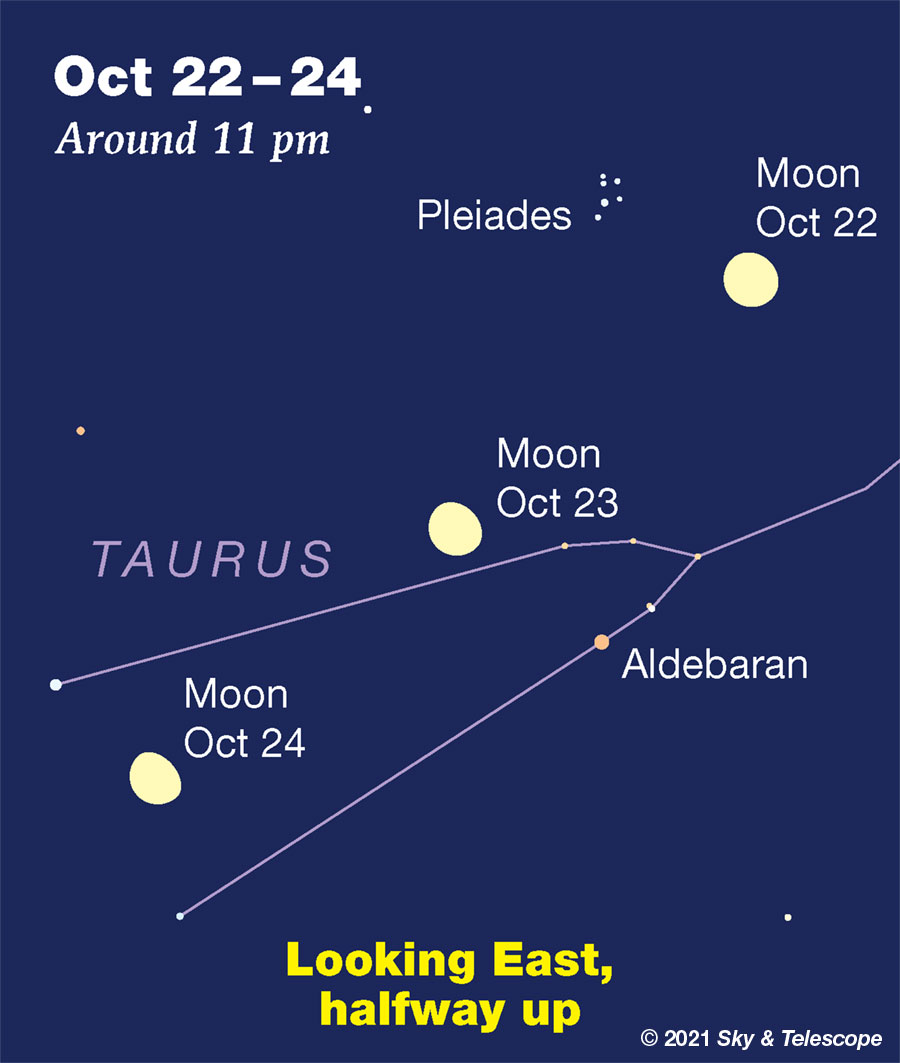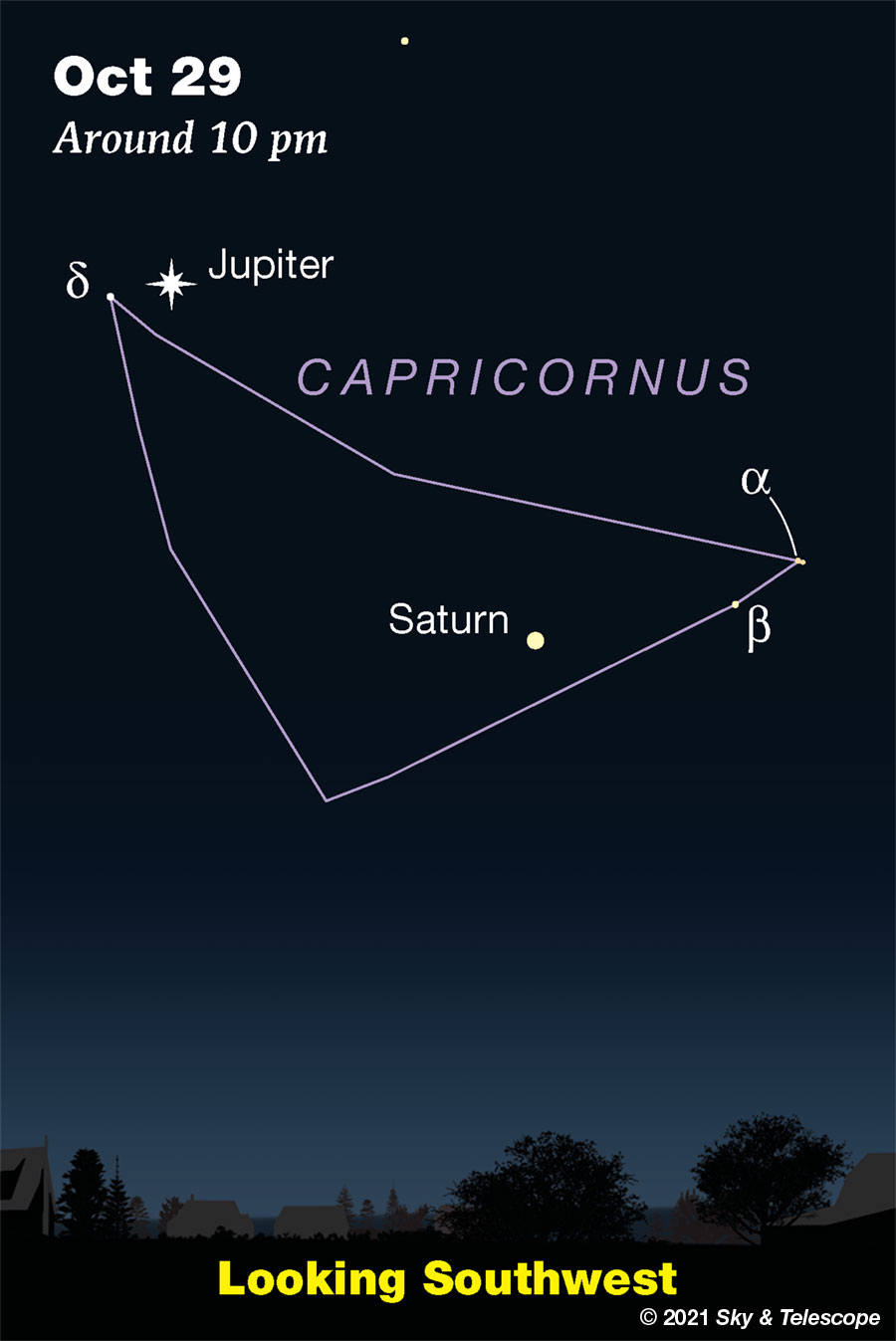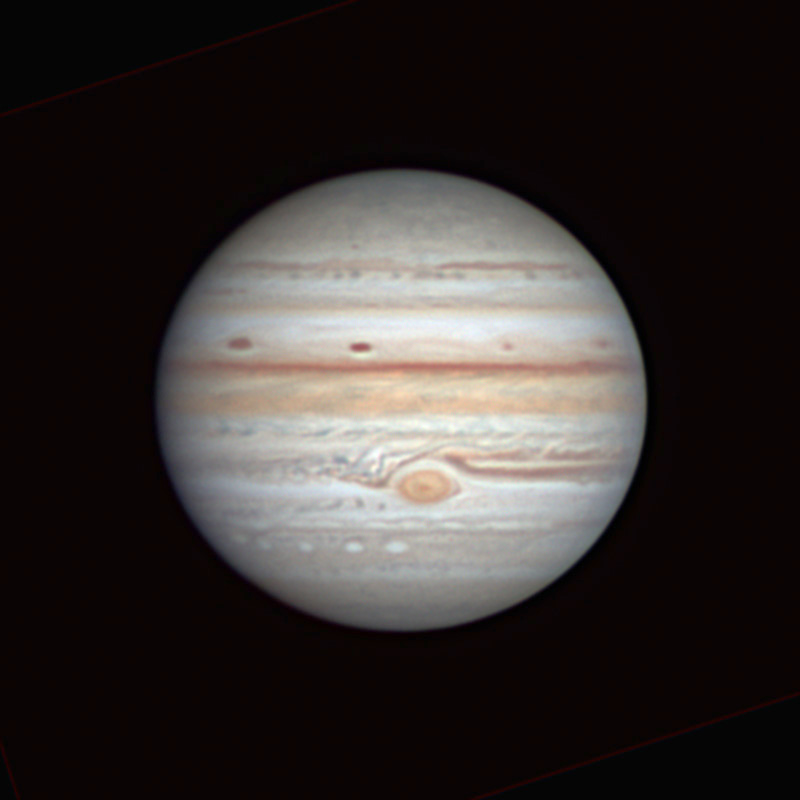We still can't look away. Nova Cassiopeiae 2021 had swelled back up to magnitude 7.0 on October 20th. This is at least its tenth rebound since it exploded last March. Charts and comparison stars.
FRIDAY, OCTOBER 22
■ The waning gibbous Moon shines in the east after dark this evening. You may need binoculars to pick out the Pleiades few degrees to its left or upper left, as shown below. Much easier is bright Capella many times farther left of the Moon.
As evening advances, Aldebaran comes up below or lower left of the Moon. By midnight, Orion is clearing the eastern horizon far below them all.
SATURDAY, OCTOBER 23
■ Tonight the waning Moon shines near Aldebaran, as shown below.

■ This is the time of year when the Big Dipper lies down horizontal low in the north-northwest after dark. How low? The farther south you are, the lower. Seen from 40° north (New York, Denver, Madrid) even its bottom stars twinkle nearly ten degrees high. But at Miami (26° N) the entire Dipper skims along out of sight just below the northern horizon.
SUNDAY, OCTOBER 24
■ This is also the time of year when W-shaped Cassiopeia stands on end (its fainter end) high in the north-northeast in early evening — and when, between Cassiopeia and the Big Dipper, the dim Little Dipper extends leftward from Polaris.
MONDAY, OCTOBER 25
■ The Ghost of Summer Suns. Halloween is approaching, and this means that Arcturus, the star sparkling low in the west-northwest in twilight, is taking on its role as "the Ghost of Summer Suns." For several evenings centered on October 25th every year, Arcturus occupies a special place above your local landscape. It closely marks the spot where the Sun stood at the same time, by the clock, during hot June and July — in broad daylight, of course!
So, as Halloween approaches every year, you can see Arcturus as the chilly ghost of the departed summer Sun.
TUESDAY, OCTOBER 26
■ This week Jupiter crosses the meridian (is highest due south) around 8:00 daylight-saving time, depending how far east or west you live in your time zone. And this month when Jupiter crosses the meridian, so does the nose star of upside-down Pegasus: Enif, aka Epsilon Pegasi. "Enif" is from the Arabic for nose, a designation adopted from the Greeks' take on Pegasus.
At magnitude 2.4, Enif is easy to spot 25° above Jupiter. That's about 2½ fists at arm's length. Sharp eyes, or binoculars, reveal that it's yellow-orange; it's a K3 supergiant.
Enif is your starting point for finding the fine fall globular cluster M15, located 5° to the star's northwest (upper right these evenings). At 6th magnitude M15 is within binocular range as a tiny glowball, and a 6-inch telescope may begin to resolve some of its sugarpile starspecks. Use the finder chart with Matt Wedel's Binocular Highlight column in the October Sky & Telescope, page 43.
WEDNESDAY, OCTOBER 27
■ Jupiter's inner moon Io enters onto the face of Jupiter's disk at 9:20 p.m. EDT, followed by Io's tiny black shadow at 10:37 p.m. EDT. Each takes about 1 hour 40 minutes to cross the planet.
Meanwhile on Jupiter itself, the Great Red Spot should cross Jupiter's central meridian around 11:24 p.m. EDT (8:24 p.m. PDT). The Red Spot is in fine position for a good 50 minutes before and after its transits. A light blue or green filter at the eyepiece helps to reveal it.
■ Got a really big scope and a dark-sky location? Now that the Moon is gone from the early evening, bring your deep-sky atlas and check out "The Odd World of Peculiar Galaxies" in the October Sky & Telescope starting on page 57, with photos and visual drawings. The ten featured galaxies are magnitudes 12 to 14.
THURSDAY, OCTOBER 28
■ Last-quarter Moon (exactly so at 4:05 p.m. Eastern Daylight Time). The half-lit Moon rises around midnight, in Cancer far below Castor and Pollux. Once the Moon is nicely up, the night is late enough that you're getting a fine preview of the winter evening sky. Spot Procyon two or three fists at arm's length right of the Moon, and brilliant Sirius the same distance right of Procyon. High over Sirius is Orion; high over Orion is Taurus with Aldebaran, the Hyades, and the Pleiades.

FRIDAY, OCTOBER 29
■ Look for bright Capella sparkling low in the northeast these evenings. Look for the Pleiades cluster about three fists at arm's length to Capella's right. These harbingers of the cold months rise higher as evening grows late — and watch for Aldebaran coming up below the Pleiades.
Upper right of Capella, and upper left of the Pleiades, the stars of Perseus lie astride the Milky Way.
SATURDAY, OCTOBER 30
■ Spot bright Altair high in the southwest soon after dark. Brighter Vega is far to its right.
Above Altair lurk two distinctive little constellations: Delphinus the Dolphin, hardly more than a fist at arm's length to Altair's upper left, and smaller, fainter Sagitta the Arrow, slightly less far to Altair's upper right. Light pollution too bright? Use binoculars!
This Week's Planet Roundup
Mercury, at the neck of stick-figure Virgo, is having its best morning apparition of the year. Look for it low above the horizon in early dawn 60 to 40 minutes before your sunrise time, just a little south of due east. It's brightening day by day: from magnitude –0.2 on the morning of October 22nd to –0.8 on the 29th.
Mars remains out of sight behind the glare of the Sun.
Venus, brilliant at magnitude –4.4, shines in southwest during twilight, crossing the feet of Ophiuchus between Antares at its lower right and the Sagittarius Teapot at its upper left. Venus now stays up about 45 minutes after twilight's end. It will continue to get higher and brighter into early December.
Jupiter and Saturn continue to shine in the south during evening, 15° apart on opposite sides of Capricornus. Jupiter is the bright one at magnitude –2.5. Saturn, to its right or lower right, is fainter at mag +0.6.
In twilight they're almost the same height, just beginning to tilt. As evening advances they tilt ever more steeply as they move westward. Saturn sets around midnight daylight-saving time, followed by Jupiter about an hour later.
Look 23° (two fists at arm's length) lower left of Jupiter for Fomalhaut, magnitude +1.2.
Here's a beginner's telescopic guide to Jupiter.

Uranus (magnitude 5.7, in southern Aries) is well up in the east by 9 or 10 p.m.
Neptune (magnitude 7.8, at the Aquarius-Pisces border) is already well up in the southeast at the end of twilight.
All descriptions that relate to your horizon — including the words up, down, right, and left — are written for the world's mid-northern latitudes. Descriptions that also depend on longitude (mainly Moon positions) are for North America.
Eastern Daylight Time, EDT, is Universal Time minus 4 hours. Universal Time is also known as UT, UTC, GMT, or Z time. To become more expert about time systems than 99% of the people you'll ever meet, see our compact article Time and the Amateur Astronomer.
Want to become a better astronomer? Learn your way around the constellations. They're the key to locating everything fainter and deeper to hunt with binoculars or a telescope.
This is an outdoor nature hobby. For an easy-to-use constellation guide covering the whole evening sky, use the big monthly map in the center of each issue of Sky & Telescope, the magazine of the American Astronomical Society.
Once you get a telescope, to put it to good use you'll need a detailed, large-scale sky atlas (set of charts). The basic standard is the Pocket Sky Atlas (in either the original or Jumbo Edition), which shows stars to magnitude 7.6.

Next up is the larger and deeper Sky Atlas 2000.0, plotting stars to magnitude 8.5; nearly three times as many. The next up, once you know your way around, are the even larger Interstellarum atlas (stars to magnitude 9.5) or Uranometria 2000.0 (stars to magnitude 9.75). And be sure to read How to Use a Star Chart with a Telescope.
You'll also want a good deep-sky guidebook, such as the big Night Sky Observer's Guide by Kepple and Sanner.
Can a computerized telescope replace charts? Not for beginners, I don't think, and not on mounts and tripods that are less than top-quality mechanically, meaning heavy and expensive. And as Terence Dickinson and Alan Dyer say in their Backyard Astronomer's Guide, "A full appreciation of the universe cannot come without developing the skills to find things in the sky and understanding how the sky works. This knowledge comes only by spending time under the stars with star maps in hand."
![]() Audio sky tour. Out under the evening sky with your
Audio sky tour. Out under the evening sky with your
earbuds in place, listen to Kelly Beatty's monthly
podcast tour of the heavens above. It's free.
"The dangers of not thinking clearly are much greater now than ever before. It's not that there's something new in our way of thinking, it's that credulous and confused thinking can be much more lethal in ways it was never before."
— Carl Sagan, 1996
"Facts are stubborn things."
— John Adams, 1770
 4
4









Comments
mary beth
October 22, 2021 at 2:30 pm
I, for one, am very scared of that Chilly Ghost of the departed summer sun! Happy HallowWeek!!
You must be logged in to post a comment.
Collin
October 22, 2021 at 4:59 pm
Sounds like the big action on Jupiter will be Wednesday the 27th, with Io's "absoprtion transit" starting early in the evening (sadly, probably too early for those on the west coast), followed by its shadow transit, and then culmination of the GRS. But Wednesday looks to be the best night from your description. Looking forward to it.
You must be logged in to post a comment.
cyrtonyx
October 26, 2021 at 3:33 pm
Saw Mercury this morning driving my school bus a 0640 MDT. Good apparition on eastern horizon in my New Mexico location.
You must be logged in to post a comment.
Rod
October 27, 2021 at 9:21 am
weather difficult for me, winds, rain yesterday and clouds. Perhaps tonight some stargazing 🙂 I was able to enjoy some views of the Sun yesterday, here is a note and report. 'A new sunspot is firing off solar eruptions and here's what it looks like on video', https://forums.space.com/threads/a-new-sunspot-is-firing-off-solar-eruptions-and-heres-what-it-looks-like-on-video.49321/
You must be logged in to post a comment.
You must be logged in to post a comment.